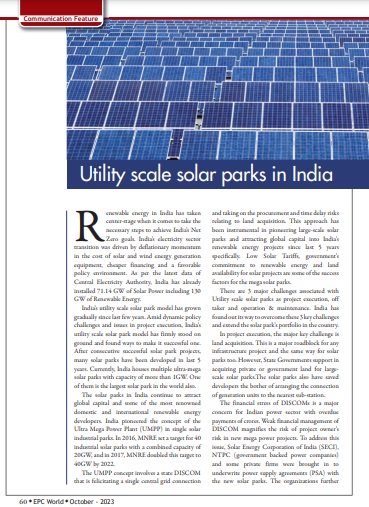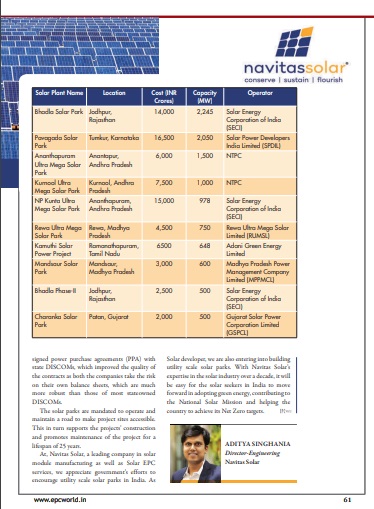Utility Scale parks in India Presents In EPC World


Renewable energy in India has taken center-stage when it comes to take the necessary steps to achieve India’s Net Zero goals. India’s electricity sector transition was driven by deflationary momentum in the cost of solar and wind energy generation equipment, cheaper financing and a favorable policy environment. As per the latest data of Central Electricity Authority, India has already installed 71.14 GW of Solar Power including 130 GW of Renewable Energy.
India’s utility scale solar park model has grown gradually since last few years. Amid dynamic policy challenges and issues in project execution, India’s utility scale solar park model has firmly stood on ground and found ways to make it successful one. After consecutive successful solar park projects, many solar parks have been developed in last 5 years. Currently, India houses multiple ultra-mega solar parks with capacity of more than 1GW. One of them is the largest solar park in the world also.
The solar parks in India continue to attract global capital and some of the most renowned domestic and international renewable energy developers. India pioneered the concept of the Ultra Mega Power Plant (UMPP) in single solar industrial parks. In 2016, MNRE set a target for 40 industrial solar parks with a combined capacity of 20GW, and in 2017, MNRE doubled this target to 40GW by 2022.
The UMPP concept involves a state DISCOM that is felicitating a single central grid connection and taking on the procurement and time delay risks relating to land acquisition. This approach has been instrumental in pioneering large-scale solar parks and attracting global capital into India’s renewable energy projects since last 5 years specifically. Low Solar Tariffs, government’s commitment to renewable energy and land availability for solar projects are some of the success factors for the mega solar parks.
There are 3 major challenges associated with Utility scale solar parks as project execution, off taker and operation & maintenance. India has found out its way to overcome these 3 key challenges and extend the solar park’s portfolio in the country.
In project execution, the major key challenge is land acquisition. This is a major roadblock for any infrastructure project and the same way for solar parks too. However, State Governments support in acquiring private or government land for large-scale solar parks. The solar parks also have saved developers the bother of arranging the connection of generation units to the nearest sub-station.
The financial stress of DISCOMs is a major concern for Indian power sector with overdue payments of crores. Weak financial management of DISCOM magnifies the risk of project owner’s risk in new mega power projects. To address this issue, Solar Energy Corporation of India (SECI), NTPC Ltd (government backed power companies) and some private firms were brought in to underwrite power supply agreements (PSA) with the new solar parks. The organizations further signed power purchase agreements (PPA) with state DISCOMs, which improved the quality of the contracts as both the companies take the risk on their own balance sheets, which are much more robust than those of most state owned DISCOMs.
The solar parks are mandated to operate and maintain a road to make project sites accessible. This in turn supports the projects’ construction and promotes maintenance of the project for a lifespan of 25 years.
Some of the mega solar parks in India are listed below:
| Solar Plant Name | Location | Cost (INR Crores) | Capacity (MW) | Operator |
|---|---|---|---|---|
| Bhadla Solar Park | Jodhpur, Rajasthan | 14,000 | 2,245 | Solar Energy Corporation of India (SECI) |
| Pavagada Solar Park | Tumkur, Karnataka | 16,500 | 2,050 | Solar Power Developers India Limited (SPDIL) |
| Ananthapuram Ultra Mega Solar Park | Anantapur, Andhra Pradesh | 6,000 | 1,500 | NTPC |
| Kurnool Ultra Mega Solar Park | Kurnool, Andhra Pradesh | 7,500 | 1,000 | NTPC |
| NP Kunta Ultra Mega Solar Park | Ananthapuram, Andhra Pradesh | 15,000 | 978 | Solar Energy Corporation of India (SECI) |
| Rewa Ultra Mega Solar Park | Rewa, Madhya Pradesh | 4,500 | 750 | Rewa Ultra Mega Solar Limited (RUMSL) |
| Kamuthi Solar Power Project | Ramanathapuram, Tamil Nadu | 6,500 | 648 | Adani Green Energy Limited |
| Mandsaur Solar Park | Mandsaur, Madhya Pradesh | 3,000 | 600 | Madhya Pradesh Power Management Company Limited (MPPMCL) |
| Bhadla Phase-II | Jodhpur, Rajasthan | 2,500 | 500 | Solar Energy Corporation of India (SECI) |
| Charanka Solar Park | Patan, Gujarat | 2,000 | 500 | Gujarat Solar Power Corporation Limited (GSPCL) |
At, Navitas Solar, a leading company in solar module manufacturing as well as Solar EPC services, we appreciate government’s efforts to encourage utility scale solar parks in India. As Solar developer, we are also entering into building utility scale solar parks. With Navitas Solar’s expertise in the solar industry over a decade, it will be easy for the solar seekers in India to move forward in adopting green energy, contributing to the National Solar Mission and helping the country to achieve its Net Zero targets.


 Online | Privacy policy
Online | Privacy policy
Related Posts
You May Also Like
Bonito Series: Driving Innovation in…
Read MoreTOPCon Series: The Next Generation…
Read MoreValuable Points to Remember During…
Read MoreNavitas Planet Partners with Hysolwin…
Read MoreDriving Towards a Sustainable Future:…
Read MoreWhy Do Top-Grade EVA Sheets…
Read MoreBonito Series: Driving Innovation in…
Read MoreTOPCon Series: The Next Generation…
Read MoreValuable Points to Remember During…
Read MoreNavitas Planet Partners with Hysolwin…
Read MoreDriving Towards a Sustainable Future:…
Read MoreWhy Do Top-Grade EVA Sheets…
Read MoreBonito Series: Driving Innovation in…
Read MoreTOPCon Series: The Next Generation…
Read MoreValuable Points to Remember During…
Read MoreNavitas Planet Partners with Hysolwin…
Read More